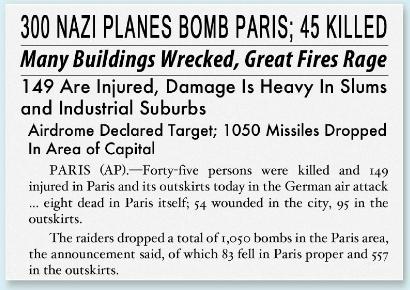|
The total German effort is given by Ulf Balke as 640 bombers and 460 fighters in what he describes as, “the single great and cohesive military demonstration by the Luftwaffe during this campaign”. Apart from aerodromes, the Citroën, Renault and Gévelot factories in the Paris suburbs were among industrial targets. The Boulogne-Billancourt and Javel neighbourhoods in the south west of the city were especially hard-hit. Some 254 people were killed and 906 were injured. The daily situation report by Göring’s Intelligence Officer recorded nine aircraft claimed by the Flak, 95 in air combat and 42 “destroyed on the ground for certain”. It was perhaps disappointment with this last figure that led him to add: It must be assumed that in addition a large number of aircraft (several hundred) were destroyed or damaged in the hangars, air arsenals and aircraft parks. Next day’s OKW communiqué, transmuted this supposition into fact: “in hangars or on the ground 300 to 400 aircraft were destroyed”. In America, the 3 June edition of the Washington Evening Star reported:
Acknowledging French censorship, the article described numerous incidents of damage in the city at unspecified locations. An Associated Press correspondent, William J. Humphreys, filed his own. eyewitness account: Ambulances and fire engines screamed across the bridge near my house. The bridge was not damaged although bombs fell near both ends. I could see the material damage done at one factory where it was reported that there were dead and wounded inside … After the bombings the French soldiers—apparently springing from the ground—took complete charge of the traffic and wounded. Ten minutes after the last explosion was heard, street department trucks appeared to patch up the holes. The whole neighbourhood began repairing the damage. The coolest man I ever saw was Henri Armand, superintendent of our apartment building. who is a veteran of the last war. Sitting calmly in the shelter in the basement, he said, “Why worry? If a bomb hits us, it hits us. This may only be the begiining”. The French government’s casualty figures had risen by 5 June to 906 in the Paris region including 254 dead of whom 195 were civilians. The same day, I./ZG 2 asked for photographs “of the PAULA undertaking”, perhaps so its crews could see the damage inflicted by the attacks. On the 6th, Paris’ Préfet de Police was congratulating the passive defence services for their devotion to duty and speedy response to the bombing while the present-day French Defence Ministry sums up the attack as follows (my translation): On 3 June 1940, Paris is bombed in the operation christened “Paula” by the Luftwaffe. The Germans’ objective is to attack the airbases of the Île-de-France [region] along with the Air Ministry and the Citroën factories (Quai Javel) which make military equipment. The massive raids take place during the afternoon. The French AA is ineffective with the exception of the Navy’s 90 mm cannon. The majority of the attacks are accurate without causing significant damage. All the same, Operation “Paula” ends in 254 dead and 652 injured — 80% of them civilians. continued on next page…
|
|||||
PART THREE OF FIVE © Nick Beale 2017–2021 |
|||||


